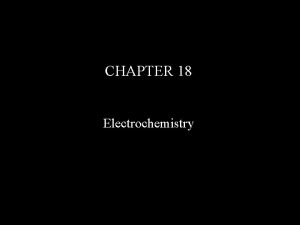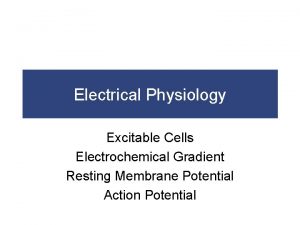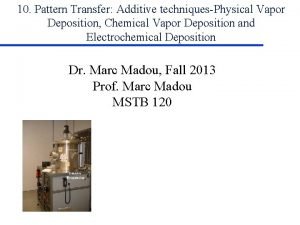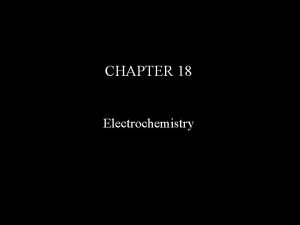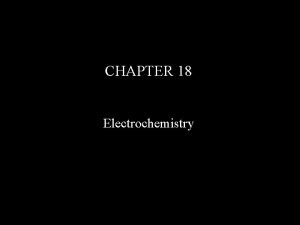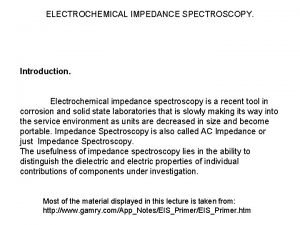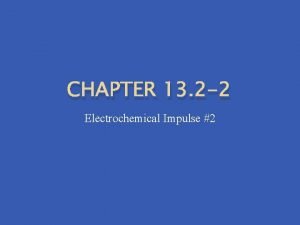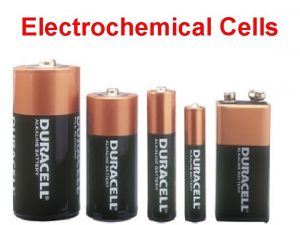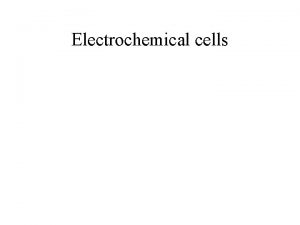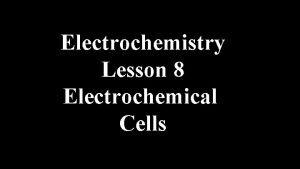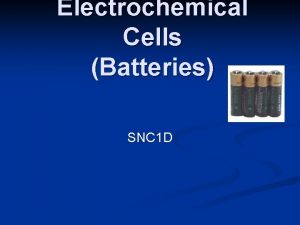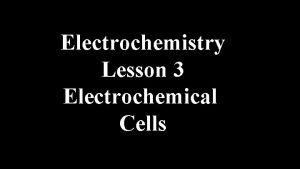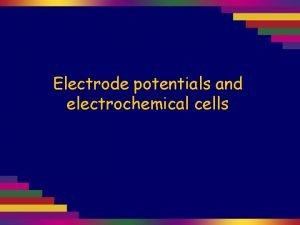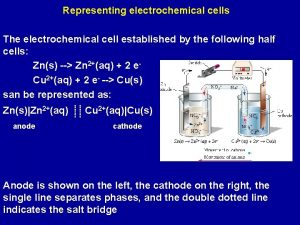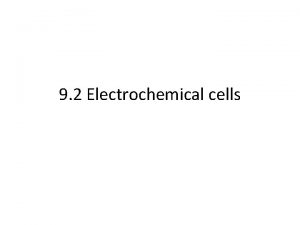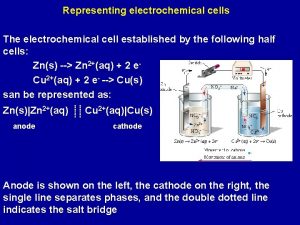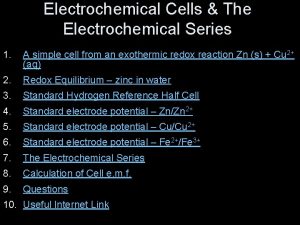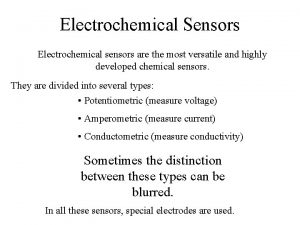Electrochemical Cells 10 1 Electrochemical cells 1 Galvanicvoltaic
















- Slides: 16


Electrochemical Cells 10. 1 Electrochemical cells 1 - Galvanic/voltaic Spontaneous 2 -Electrolytic Non-spontaneous

REDOX reactions take place in electrochemical cells. There are two types a) Spontaneous reactions occur in galvanic (voltaic) cells; b) non-spontaneous reactions occur in electrolytic cells. Many oxidation-reduction reactions occur spontaneously, giving off energy. When a piece of metallic zinc is dipped in a solution of copper sulfate, the zinc is coated with metallic copper, and zinc ions pass into the solution

There is a direct transfer from zinc to copper ions. The energy produced in this reaction is quickly dissipated as heat, but it can be made to do useful work by a device called, an electrochemical cell. Made of two compartments or half-cells, each composed of an electrode dipped in a solution of electrolyte. This keeps the reactions separate.

The half-cell, called the anode, is the site at which the oxidation of zinc occurs. Zn (s) -----> Zn+2 (aq) + 2 e- The half-cell, called the cathode, is the site at which reduction of copper occurs. Cu+2 (aq) + 2 e- -------> Cu (s) Nothing will happen unless the two half cells are connected to each other. But, each half-cell will produce an imbalance of electrical charge, the anode becomes more positive Zn 2+ are produced, and the cathode would become more negative as Cu 2+ are removed from solution…problem develops…to much charge accumulation. Like charges repel… This problem can be solved by using a "salt bridge" connecting the two cells

A "salt bridge" is a porous barrier that allows the migration of ions in both directions to maintain electrical neutrality.

As the oxidation-reduction reaction occurs, cations ( Zn+2) from the anode migrate via the salt bridge to the cathode, while the anion, (SO 4)-2, migrates in the opposite direction to maintain electrical neutrality. Copper and zinc plates (the electrodes) are linked externally by a conducting wire, which completes the circuit. Electrons from the oxidation reaction are forced to travel via an external circuit to the site of the reduction reaction. A spontaneous reaction indicates that there is a difference in potential energy also called electromotive force (emf) and is measured in terms of volts. The zinc/copper cell has an emf of about 1. 1 volts under standard conditions (1 mol/L solutions and SATP).

When both the electrolyte concentrations are 0. 1 mol. /L and the temperature is 25 ºC, the cell is said to be a standard cell. )(0. 1 mol/L) Draw a similar diagram for the copper-silver cell. Use arrows to show the directions of ions and e-. Page 700 #3, 5, 6 -9

Summary e- e- Anode e. Reducing Agent Cathode e. Oxidizing Agent

Summary of electrochemical cells: The ANODE. . . The CATHODE. . . supplies electrons to the external circuit (wire) accepts electrons from the external circuit (wire) is the negative pole of the battery is the positive pole of the battery is the site of OXIDATION is the site of REDUCTION is written on the left hand side if the convention is followed is written on the right hand side if the convention is followed is the half-cell with the lowest electrode potential is the half-cell with the highest electrode potential

homework § See unit at a glance

Electrolytic Cells

The redox reaction in an electrolytic cell is nonspontaneous. Electrical energy is required to induce the electrolysis reaction. An example of an electrolytic cell is shown below, in which molten Na. Cl is electrolyzed to form liquid sodium and chlorine gas. The sodium ions migrate toward the cathode, where they are reduced to sodium metal. Similarly, chloride ions migrate to the anode and are oxidized to form chlorine gas. This type of cell is used to produce sodium and chlorine. The chlorine gas can be collected surrounding the cell. The sodium metal is less dense than the molten salt and is removed as it floats to the top of the reaction container

Sodium Sulfate Solution § Two cylinders containing a sodium sulfate solution are connected with tubing. Each has a platinum electrode connected to a power supply. § Bromothymol Blue indicator is in the sodium sulfate solution. The top vial shows the indicator color in the acid, the middle in neutral solution, and the bottom in base.

§ When electricity passes through the system, oxidation occurs at one electrode and reduction at the other. § Gas is formed at each electrode, and the acidity increases at one electrode and decreases at the other.

§ At the anode, water molecules produce oxygen gas, hydrogen ions, and electrons. H 2 O (l) O 2 (g) + H+ (aq) H 2 O (l) H 2 (g) + OH- (aq) § The electrons flow through the circuit to the cathode, where they react with water to produce hydrogen gas and hydroxide ions. § If the solution is stirred, acid-base neutralization will occur. H+ (g) + OH- (aq) H 2 O(l)
 Half cell reaction
Half cell reaction What are electrochemical series
What are electrochemical series Refractory period anatomy
Refractory period anatomy What is electrochemistry
What is electrochemistry The stage that creates an “electrochemical gradient”. *
The stage that creates an “electrochemical gradient”. * Electrochemical deposition
Electrochemical deposition Electrochemical deposition
Electrochemical deposition Electrochemical gradient
Electrochemical gradient Differences between nervous system and endocrine
Differences between nervous system and endocrine Electrochemical series order
Electrochemical series order Electrochemical series
Electrochemical series Electrochemical impedance spectroscopy
Electrochemical impedance spectroscopy Oxidation of ethanol
Oxidation of ethanol Stress corrosion
Stress corrosion Waterline corrosion
Waterline corrosion Giner electrochemical systems
Giner electrochemical systems Electrochemical impulse
Electrochemical impulse

